Training your triceps is a important part of growing and defining your arms. Whether you are a training fanatic or developing your first training plan, the exercises below will help you meet your fitness goals.
push-up close-grip off dumbbell
To perform the push-up close-grip off dumbbell exercise, follow these steps:
1. Start by placing a dumbbell on the floor. Ensure it's stable and won't roll away.
2. Position yourself into a high plank position, with your hands gripping the dumbbell. Your hands should be closer than shoulder-width apart. This is your starting position.
3. Lower your body towards the floor, keeping your elbows close to your body as you do so. This helps to target your triceps.
4. Push your body back up to the starting position, extending your arms fully but without locking your elbows.
5. Repeat this movement for your desired number of repetitions.
Remember to keep your body straight and your core engaged throughout the exercise. Breathe in as you lower your body and breathe out as you push back up. If you find this exercise too challenging, you can modify it by performing the push-ups from your knees instead of your toes.
exercise ball supine triceps extension
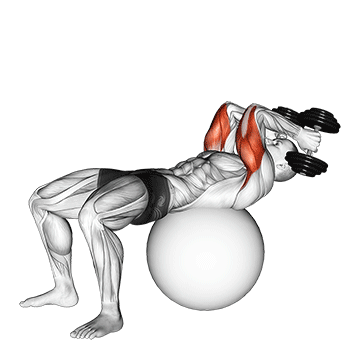
To perform the exercise ball supine triceps extension, follow these steps:
1. Start by sitting on an exercise ball with a dumbbell in each hand. Your feet should be flat on the floor, hip-width apart.
2. Slowly walk your feet forward, rolling down the ball until your upper back and shoulders are resting on the ball. Your knees should be bent at a 90-degree angle, and your body should form a straight line from your knees to your shoulders.
3. Extend your arms straight up over your chest, holding the dumbbells with your palms facing each other.
4. Slowly bend your elbows, lowering the dumbbells down towards your shoulders. Keep your elbows close to your body and ensure they are the only parts moving. Your upper arms should remain stationary.
5. Pause for a moment when your elbows are at a 90-degree angle, then push the dumbbells back up to the starting position by extending your elbows and contracting your triceps.
6. Repeat this movement for your desired number of repetitions.
Remember to keep your core engaged throughout the exercise to maintain balance on the ball. Also, ensure you choose a weight that allows you to perform the exercise with proper form. If you're new to this exercise, start with lighter weights and gradually increase as your strength improves.
dumbbells seated triceps extension
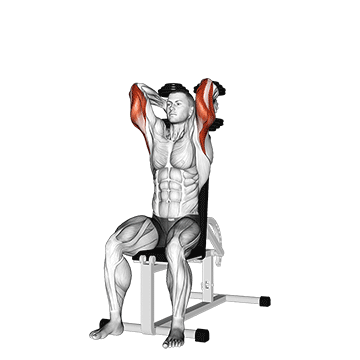
1. Start by sitting on a flat bench with your feet firmly planted on the ground. Keep your back straight and your core engaged.
2. Hold a dumbbell in both hands, palms facing each other. Lift the dumbbell over your head until both arms are fully extended.
3. Slowly lower the dumbbell behind your head while keeping your upper arms still. The only part of your body that should move is your forearms. This is your starting position.
4. Using your triceps, lift the dumbbell back to the starting position. Make sure to keep your upper arms stationary and only move your forearms.
5. Repeat this movement for the desired number of repetitions.
6. Remember to keep your movements slow and controlled, focusing on the muscle contraction and not on the weights you are lifting.
7. Avoid using your back or shoulders to lift the weights; your triceps should do all the work.
8. Breathe in as you lower the dumbbell and breathe out as you lift it back up.
9. Always ensure your form is correct to avoid injury and maximize the effectiveness of the exercise.
dumbbell twisting bench press
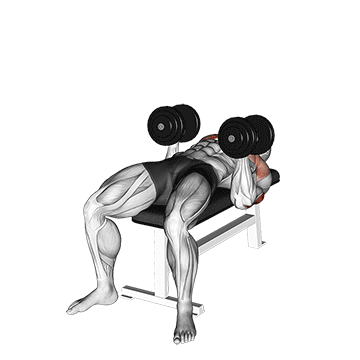
To perform the dumbbell twisting bench press, start by sitting on a flat bench with a dumbbell in each hand. Your feet should be flat on the floor for stability.
Lie back on the bench, holding the dumbbells at shoulder width. Your palms should be facing your feet and the dumbbells should be just to the sides of your chest, with your upper arm and forearm creating a 90 degree angle at elbow joint.
Push the dumbbells up with your chest. The dumbbells should be just about directly above your chest. As you push up, twist your wrists inward so that at the top of the movement, your palms are facing each other.
After a brief pause at the top contracted position, start to come down slowly. As you come down, twist your wrists back to the starting position where your palms are facing your feet.
Repeat this movement for the recommended amount of repetitions.
Remember to keep full control of the dumbbells at all times. Do not use your wrists to lift the weights; use your triceps to push the dumbbells up and out. This exercise should be done in a smooth, controlled movement on the way down and a powerful push on the way up.
dumbbell tricep kickback with stork stance
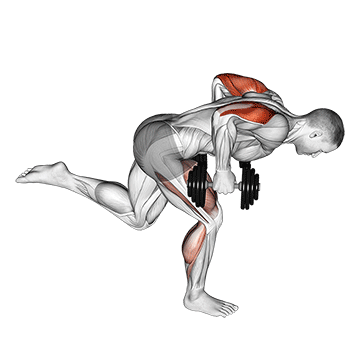
To perform the dumbbell tricep kickback with stork stance, follow these steps:
1. Start by selecting a dumbbell of appropriate weight. Remember, it's better to start light and increase the weight as you get comfortable with the exercise.
2. Stand on your left leg, bending slightly at the knee for stability. Lift your right foot off the ground, maintaining balance.
3. Hold the dumbbell in your right hand. Bend at your waist, leaning forward slightly, keeping your back straight. Your upper body should be almost parallel to the floor.
4. Bend your right elbow to a 90-degree angle, keeping your upper arm close to your body. This is your starting position.
5. Exhale and extend your right arm behind you, focusing on the tricep muscle. Keep your arm close to your body as you do this. Ensure your arm is fully extended but do not lock your elbow.
6. Hold this position for a moment, feeling the contraction in your tricep.
7. Inhale and slowly return your arm to the starting position.
8. Repeat this movement for your desired number of repetitions.
9. Once you've completed your set, switch to standing on your right leg and repeat the exercise with your left arm.
Remember to keep your core engaged throughout the exercise to maintain balance and stability. This exercise not only targets your triceps but also helps improve your balance and core strength.
dumbbell tate press
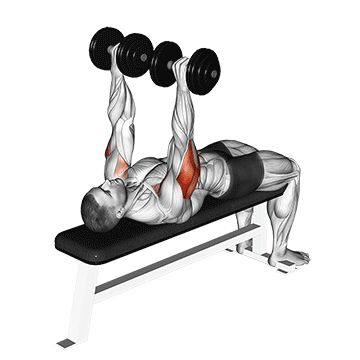
To perform the dumbbell tate press, follow these steps:
1. Start by sitting on a flat bench with a dumbbell in each hand. Your feet should be flat on the floor.
2. Lie back on the bench, raising the dumbbells over your chest with your arms fully extended. The palms of your hands should be facing your feet.
3. Bend your elbows to lower the dumbbells towards your chest. The dumbbells should be close to your chest and the sides of the dumbbells should be touching each other. This is your starting position.
4. Push the dumbbells back up by extending your elbows and flexing your triceps. The dumbbells should move in an arc-like motion towards your chest and then back up again.
5. Pause for a moment at the top of the movement, then slowly lower the dumbbells back to the starting position.
6. Repeat for the desired number of repetitions.
Remember to keep your elbows close to your body throughout the movement to ensure your triceps are doing the work. Also, control the movement of the dumbbells, don't let them control you. This exercise should be done with a weight that allows you to complete the desired number of repetitions with good form.
dumbbell standing triceps extension
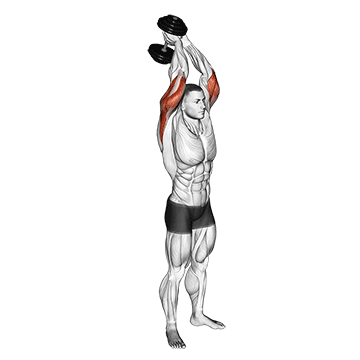
1. Stand upright with your feet shoulder-width apart. Hold a dumbbell in both hands. Your palms should be facing towards the ceiling.
2. Extend your arms fully above your head. This is your starting position.
3. Slowly bend your elbows to lower the dumbbell behind your head. Keep your upper arms stationary and close to your head at all times. The forearms should do most of the work. Continue to lower the weight until your arms are fully bent.
4. Pause for a moment at the bottom of the movement, then slowly extend your arms back to the starting position.
5. Keep your back straight and your core engaged throughout the exercise.
6. Repeat this movement for the desired number of repetitions.
Remember to keep your movements slow and controlled, focusing on the muscle contraction and not on the weights you are lifting. Avoid using your back or shoulders to lift the weights; your triceps should do the work. If the weight is too heavy, reduce it to maintain proper form.
dumbbell standing one arm extension
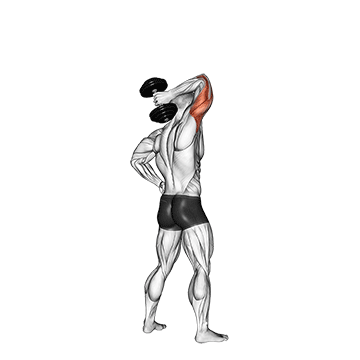
1. Stand up straight with a dumbbell in one hand. Your feet should be about shoulder-width apart.
2. Raise the dumbbell above your head until your arm is fully extended. Keep your elbow close to your head and your arm perpendicular to the floor. This is your starting position.
3. Slowly lower the dumbbell behind your head while keeping your upper arm still. Continue to lower the weight until your forearm makes about a 90-degree angle with your upper arm. This is the bottom position of the exercise.
4. Pause for a moment at the bottom, then use your triceps to return the dumbbell back to the starting position.
5. Repeat the movement for the desired number of repetitions.
6. Once you're done with one arm, switch the dumbbell to the other hand and repeat the exercise.
Remember to keep your back straight and your core engaged throughout the exercise. Also, ensure that your elbow doesn't flare out to the sides; it should stay close to your head. The movement should be slow and controlled, focusing on the contraction and extension of the tricep muscle.
dumbbell standing kickback
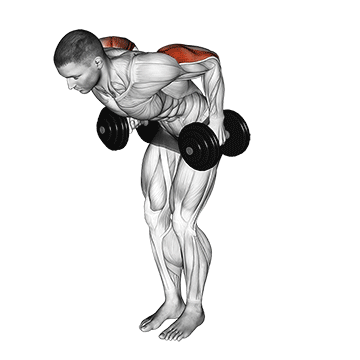
To perform the dumbbell standing kickback, start by selecting a pair of dumbbells of appropriate weight. Stand up straight with a dumbbell in each hand, arms fully extended, and palms facing your torso. Keep your feet shoulder-width apart.
Bend your knees slightly and bend over as far as possible while keeping your back straight. Your torso should be almost parallel to the floor. This is your starting position.
Keep your upper arms close to your torso and parallel to the floor. The forearms should be pointed towards the floor as you hold the weights. There should be a 90-degree angle formed between your upper arm and forearm. This is your starting position.
Now, while keeping your upper arms stationary, exhale and use your triceps to lift the weights until the arm is fully extended. Focus on moving the forearm.
After a brief pause at the top contraction, inhale and slowly lower the dumbbells back down to the starting position.
Repeat the movement for the prescribed amount of repetitions. Be sure to keep your upper arm stationary throughout the exercise to ensure the triceps are fully engaged.
dumbbell standing bent over two arm triceps extension
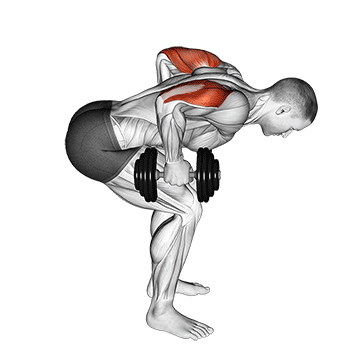
1. Stand upright with your feet shoulder-width apart. Hold a dumbbell in each hand with your palms facing each other.
2. Bend your knees slightly and hinge at your waist, so your torso is almost parallel to the floor. Keep your back straight.
3. Keep your upper arms close to your body and your head in line with your spine. Your forearms should be pointed towards the floor as you hold the dumbbells.
4. Without moving your upper arms, slowly raise the dumbbells until your arms are fully extended. Ensure your triceps are doing the work.
5. Pause for a moment at the top of the movement, then slowly lower the dumbbells back to the starting position.
6. Repeat this movement for your desired number of repetitions.
Remember to keep your movements controlled, don't use your back or shoulders to lift the weights - your triceps should do all the work. Also, avoid locking your elbows when you extend your arms, and always keep your core engaged to maintain balance.
dumbbell standing bent over one arm triceps extension
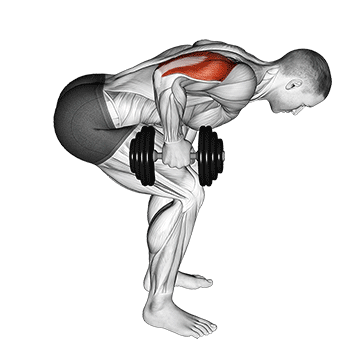
1. Stand up straight with a dumbbell in one hand. Your feet should be about shoulder-width apart.
2. Bend your knees slightly and bring your torso forward by bending at the waist. Keep your back straight until it's almost parallel to the floor.
3. The arm holding the dumbbell should be extended and placed perpendicular to the floor and your torso. This is your starting position.
4. Keeping your upper arm stationary, use your triceps to lift the weights until the arm is fully extended. Breathe out as you perform this step.
5. After a brief pause at the top contraction, inhale and slowly lower the dumbbell back down to the starting position.
6. Repeat the movement for the prescribed amount of repetitions of your training program.
7. Switch arms and repeat the exercise.
Remember to keep your back straight and your movements controlled. The only part of your body that should move is your forearm.
dumbbell standing alternating tricep kickback
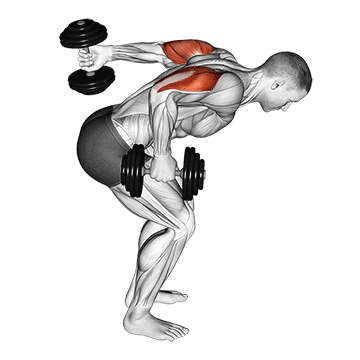
1. Stand upright with a dumbbell in each hand, your feet shoulder-width apart. Your palms should be facing your torso and your elbows should be close to your torso. This is your starting position.
2. Keeping your upper arms stationary, exhale and extend the dumbbell in one hand backwards until your arm is fully extended. Ensure your torso is stationary and only the forearm moves.
3. Hold the contraction at the top for a second, then inhale and slowly lower the dumbbell back to the starting position.
4. Repeat the movement with the other arm. This completes one rep.
5. Continue alternating arms for the desired number of repetitions.
Remember to keep your back straight and your movements controlled throughout the exercise. The focus should be on the tricep muscle at the back of your upper arm.
dumbbell seated triceps extension
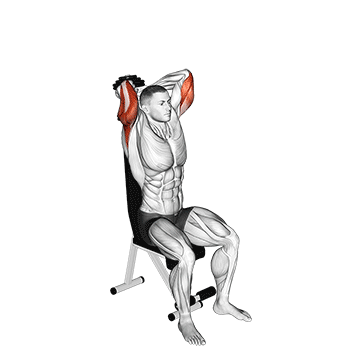
1. Start by sitting on a flat bench with your feet firmly planted on the ground. Hold a dumbbell in both hands, palms facing each other.
2. Lift the dumbbell over your head until both arms are fully extended. This is your starting position.
3. Keeping your upper arms stationary, slowly bend at the elbows to lower the dumbbell behind your head. Your forearms should be the only part of your arms moving.
4. Lower the dumbbell as far as comfortably possible, ensuring you maintain control of the weight at all times.
5. Pause for a moment at the bottom of the movement, then use your triceps to extend your arms and raise the dumbbell back to the starting position.
6. Repeat this movement for the desired number of repetitions. Ensure you keep your elbows close to your head throughout the exercise to maximize triceps engagement.
7. Remember to breathe in as you lower the dumbbell and breathe out as you lift it back to the starting position.
8. Always maintain a straight back and keep your head up to avoid straining your neck.
9. Start with a lighter weight to ensure you have the correct form and gradually increase the weight as your strength improves.
10. If you feel any discomfort or pain during the exercise, stop immediately and consult with a fitness professional.
dumbbell seated reverse grip one arm overhead tricep extension
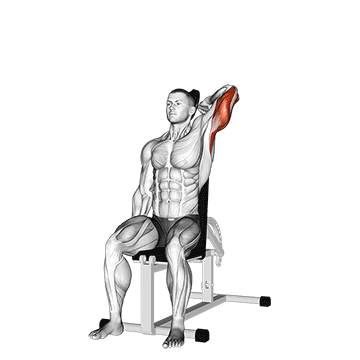
1. Start by sitting on a flat bench with your feet firmly planted on the ground. Hold a dumbbell in one hand with a reverse grip, meaning your palm should be facing towards you.
2. Extend your arm straight up towards the ceiling, keeping your elbow close to your head. This is your starting position.
3. Slowly bend your elbow to lower the dumbbell behind your head. Keep your upper arm stationary and only move your forearm. Continue lowering the weight until your arm is fully bent and the dumbbell is about level with your head.
4. Pause for a moment at the bottom of the movement, then use your triceps to extend your arm back to the starting position.
5. Repeat for the desired number of repetitions, then switch to the other arm.
6. Remember to keep your back straight and your core engaged throughout the exercise to protect your spine and maximize the effectiveness of the movement.
7. For best results, perform this exercise slowly and with control, focusing on the muscle contraction and not on the weights you are lifting.
8. Avoid using your shoulders or back to lift the weight; your triceps should do all the work.
9. If you feel any pain in your elbow or shoulder, reduce the weight or stop the exercise.
dumbbell seated one arm kickback
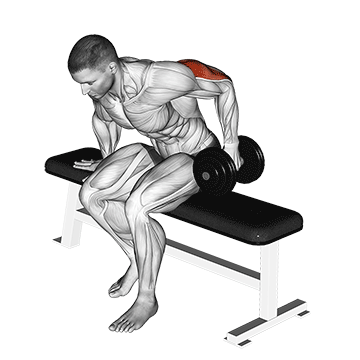
Begin by sitting on a flat bench with a dumbbell in one hand. Lean forward slightly from your waist, keeping your back straight. Your feet should be flat on the floor for stability.
Hold the dumbbell with your palm facing your torso. Keep your upper arm close to your torso and parallel to the floor. This is your starting position.
Exhale and use your triceps to lift the dumbbell until your arm is fully extended behind you. Ensure that the upper arm remains stationary and only the forearm moves.
Hold the contracted position for a moment and then inhale as you slowly lower the dumbbell back to the starting position.
Repeat for the recommended amount of repetitions and then switch arms.
Remember to keep your back straight and your movements controlled throughout the exercise. Avoid using your back or shoulders to lift the weight; your triceps should do all the work.
dumbbell seated kickback
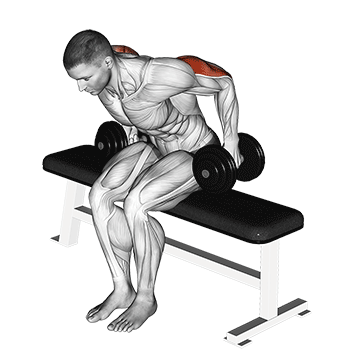
1. Start by sitting on a flat bench with your feet firmly planted on the ground. Hold a dumbbell in each hand with your palms facing inwards.
2. Bend forward slightly from your waist while keeping your back straight. Your chest should be almost parallel to the floor.
3. Pull your elbows up so that your upper arms are parallel to the floor and close to your torso. This is your starting position.
4. Without moving your upper arms, extend the dumbbells behind you until your arms are fully extended. Ensure you're using your triceps to push the weights up.
5. Pause for a moment at the top of the movement, squeezing your triceps.
6. Slowly lower the dumbbells back to the starting position, maintaining control of the weights at all times.
7. Repeat for the desired number of repetitions.
Remember to keep your back straight and your movements controlled throughout the exercise. Avoid using your back or shoulders to lift the weights; your triceps should be doing the work.
dumbbell seated bent over triceps extension
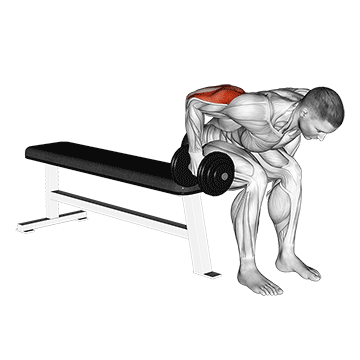
1. Start by sitting on a flat bench with your feet firmly planted on the ground. Hold a dumbbell in each hand with your palms facing each other.
2. Bend at the waist while keeping your back straight until your torso is almost parallel to the floor. Your head should be up and your knees should be slightly bent.
3. Keep your upper arms close to your torso and parallel to the floor. This is your starting position.
4. As you breathe in, slowly lower the dumbbells in a semicircular motion behind your head until your forearms touch your biceps. The upper arms should remain stationary and only the forearms should move.
5. Breathe out and use your triceps to bring the dumbbell back to the starting position.
6. Repeat the movement for the prescribed amount of repetitions.
7. Ensure to keep your elbows close to your body throughout the movement. Do not use your back or shoulders to lift the weights; your triceps should do all the work.
8. Perform the same steps with the other arm.
Remember to perform this exercise slowly and deliberately, focusing on the muscle contraction and not on the weights you are lifting.
dumbbell seated bent over alternate kickback
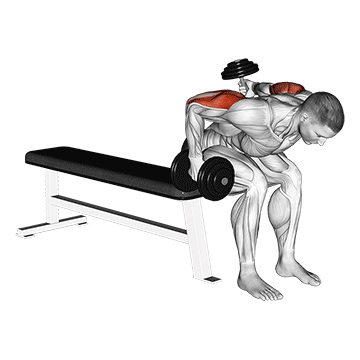
1. Start by sitting on the edge of a flat bench with your feet firmly planted on the ground. Hold a dumbbell in each hand with your palms facing inwards.
2. Bend forward from your waist until your chest is almost parallel to the floor. Keep your back straight and your head up.
3. Extend your arms fully so they are perpendicular to the floor. This is your starting position.
4. Keeping your upper arms stationary, exhale and use your triceps to lift one dumbbell until the arm is fully extended. Focus on moving the forearm.
5. After a brief pause at the top contraction, inhale and slowly lower the dumbbell back to the starting position.
6. Repeat the movement with the other arm. This completes one rep.
7. Continue alternating between both arms for the desired number of repetitions.
Remember to keep your upper arms close to your torso and parallel to the floor throughout the exercise to isolate the triceps. Also, avoid using your back or shoulders to lift the weights; your forearms should do all the work.
dumbbell seated bench extension
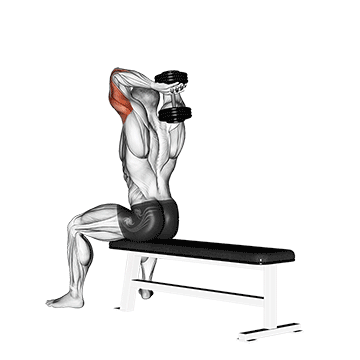
1. Start by sitting down on a flat bench with a dumbbell in each hand. Your feet should be flat on the floor for stability.
2. Lift the dumbbells over your head until both arms are fully extended. The palms of your hands should be facing up and the dumbbells should be touching each other.
3. Keep your upper arms close to your head with elbows in and perpendicular to the floor. This is your starting position.
4. Slowly lower the dumbbells in a semicircular motion towards your shoulders. Keep your upper arms stationary and use your forearms to bring the weights down.
5. Pause for a moment when the dumbbells are close to your shoulders and then use your triceps to return the dumbbells to the starting position.
6. Repeat the movement for the desired amount of repetitions.
7. Remember to keep your back straight and your movements controlled throughout the exercise. Avoid using your back or shoulders to lift the weights; your triceps should do all the work.
8. Breathe in as you lower the weights and breathe out as you lift them back up.
9. Always use a weight that's challenging but still allows you to perform the exercise with proper form.
dumbbell pronate-grip triceps extension
To perform the dumbbell pronate-grip triceps extension, follow these steps:
1. Stand or sit on a bench, holding a dumbbell in each hand with your feet shoulder-width apart.
2. Extend your arms fully above your head. This is your starting position.
3. Slowly bend your elbows to lower the dumbbells behind your head. Keep your elbows close to your head and perpendicular to the floor.
4. Pause for a moment when your forearms are parallel to the floor, then use your triceps to return the dumbbells to the starting position.
5. Make sure to keep your upper arms stationary throughout the exercise. The movement should only occur at your elbow joint.
6. Repeat for the desired number of repetitions.
Remember to use a weight that is challenging but allows you to maintain proper form. Always keep your back straight and avoid using your shoulders or back to lift the weight. The focus should be on your triceps.
dumbbell palms in incline bench press
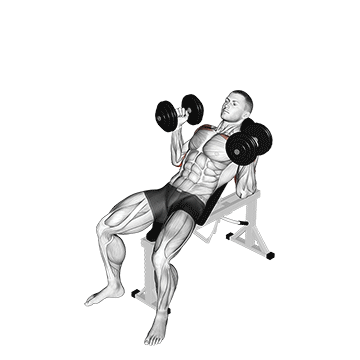
1. Start by setting an incline bench at a 45-degree angle.
2. Grab a pair of dumbbells and sit down on the bench. Place the dumbbells on your thighs near your knees.
3. Lean back onto the bench, using your thighs to help lift the dumbbells up. Hold the dumbbells at shoulder width with your palms facing each other.
4. Push the dumbbells up until your arms are fully extended above your chest. This is your starting position.
5. Slowly lower the dumbbells down to the sides of your chest while keeping your elbows close to your body. Ensure your palms are still facing each other.
6. Pause for a moment at the bottom of the movement, then push the dumbbells back up to the starting position.
7. Repeat this movement for your desired number of repetitions.
8. When you're done, do not drop the dumbbells next to you as this is dangerous. Instead, drop them on your thighs and then on the floor.
Remember to keep your movements slow and controlled, focusing on the muscle contraction and not on the weights you are lifting. Breathe in as you lower the weights and breathe out as you lift them.
dumbbell one arm triceps extension (on bench)
_Upper-Arms_360.gif)
1. Start by selecting a dumbbell of appropriate weight. Remember, it's better to start light and increase weight as you get comfortable with the exercise.
2. Sit on the edge of a flat bench and plant your feet firmly on the ground. Hold the dumbbell in one hand and extend your arm straight up towards the ceiling. This is your starting position.
3. Slowly bend your elbow, lowering the dumbbell behind your head. Keep your upper arm stationary and close to your head at all times. The forearms should do all the work.
4. Continue to lower the dumbbell until your forearm and bicep form a 90-degree angle. Ensure that the dumbbell is lowered in a controlled manner.
5. Pause for a moment at the bottom of the movement, then use your triceps to return the dumbbell back to the starting position.
6. Repeat the movement for the desired number of repetitions. Once you're done, switch arms and perform the same number of repetitions.
7. Remember to keep your back straight and your core engaged throughout the exercise to maintain balance and stability.
8. Avoid using your back or shoulders to lift the weight; your triceps should do all the work. If you find your form slipping, consider reducing the weight of the dumbbell.
9. Perform this exercise for 2-3 sets of 8-12 repetitions per arm, depending on your fitness level and goals.
10. Always ensure to warm up before starting the exercise and cool down afterwards to prevent injury and promote muscle recovery.
dumbbell one arm kickback
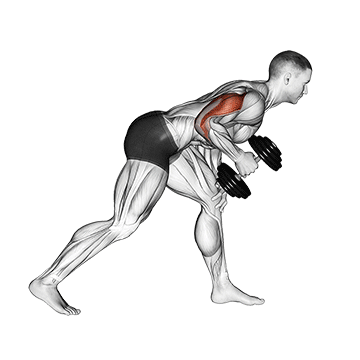
To perform the dumbbell one arm kickback, start by selecting a dumbbell of appropriate weight. Stand with your feet hip-width apart and hold the dumbbell in one hand.
Bend your knees slightly and lean forward from your waist, maintaining a straight back. Your torso should be almost parallel to the floor.
Hold your upper arm close to your torso and parallel to the floor. Your forearm should be pointed towards the floor as you hold the dumbbell at a right angle with your arm. This is your starting position.
Exhale and extend your arm backwards, lifting the dumbbell in a smooth arc until your arm is fully extended and parallel to the floor. Ensure your upper arm remains stationary and only your forearm moves.
Hold this position for a moment, feeling the contraction in your triceps.
Inhale and slowly lower the dumbbell back to the starting position.
Repeat this movement for the desired number of repetitions. Once you're done, switch arms and repeat the exercise.
Remember to keep your back straight and your movements controlled throughout the exercise. Avoid using your back or shoulders to lift the weight; your triceps should do the work.
dumbbell one arm hammer press on exercise ball
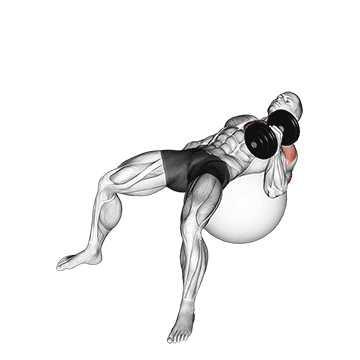
1. Start by selecting a dumbbell of appropriate weight. Remember, it's better to start light and increase weight as you get comfortable with the exercise.
2. Sit on an exercise ball with your feet flat on the floor. The ball should be large enough that your knees are bent at a 90-degree angle when you're sitting on it.
3. Hold the dumbbell in your right hand with a neutral grip, meaning your palm should be facing inward towards your body.
4. Lean forward slightly from your hips, keeping your back straight. This is your starting position.
5. Bend your elbow and lower the dumbbell behind your head. Your upper arm should remain stationary and close to your head at all times. This is the eccentric part of the exercise.
6. Push the dumbbell back up to the starting position by extending your elbow and using your triceps to lift the weight. This is the concentric part of the exercise.
7. Repeat the movement for the desired number of repetitions.
8. Once you've completed your set, switch the dumbbell to your left hand and repeat the exercise.
9. Remember to keep your core engaged throughout the exercise to maintain balance on the ball and to protect your lower back.
10. Breathe in as you lower the dumbbell and breathe out as you lift it.
Remember, form is more important than weight. It's better to perform the exercise correctly with a lighter weight than to risk injury with a weight that's too heavy.
dumbbell one arm french press on exercise ball
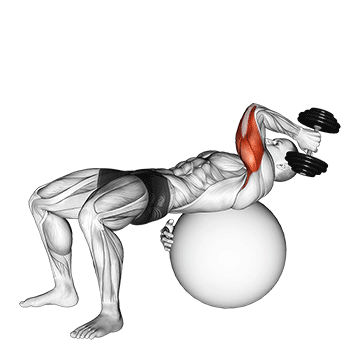
1. Start by selecting a dumbbell of appropriate weight. Remember, it's better to start light and increase weight as you get comfortable with the exercise.
2. Sit on an exercise ball with your feet flat on the floor, shoulder-width apart for stability. Hold the dumbbell in one hand and extend your arm straight up towards the ceiling.
3. Bend your elbow to lower the dumbbell behind your head. Your upper arm should remain stationary and only your forearm should move. This is your starting position.
4. Push the dumbbell back up by extending your elbow and flexing your tricep. Keep your upper arm still throughout the movement.
5. Pause for a moment at the top of the movement, then slowly lower the dumbbell back to the starting position.
6. Repeat the movement for your desired number of repetitions. Once you've completed your set, switch arms and repeat the exercise.
7. Remember to keep your back straight and your core engaged throughout the exercise to protect your spine and maximize the effectiveness of the exercise.
8. Breathe in as you lower the dumbbell and breathe out as you push it back up. This will help you maintain a steady rhythm and ensure your muscles are getting the oxygen they need.
9. Always perform this exercise in a controlled manner. Avoid using momentum to lift the weight, as this can lead to injury and won't effectively target your triceps.
dumbbell neutral grip bench press
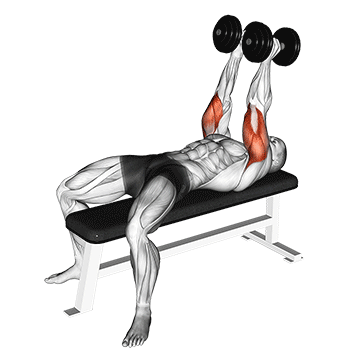
1. Start by sitting down on a flat bench with a dumbbell in each hand. Your feet should be flat on the floor for stability.
2. Slowly lay back onto the bench, bringing the dumbbells to the sides of your chest. Your palms should be facing each other, hence the term "neutral grip."
3. Push the dumbbells up and away from your chest until your arms are fully extended. Ensure your elbows are not locked to avoid injury.
4. Pause for a moment at the top of the movement, then slowly lower the dumbbells back down to the sides of your chest.
5. Make sure to keep your elbows close to your body throughout the movement to ensure your triceps are doing the work.
6. Repeat this movement for your desired number of repetitions.
Remember to always use a weight that is challenging but allows you to maintain proper form. If you're new to this exercise, it may be helpful to have a spotter nearby.
dumbbell lying triceps extension
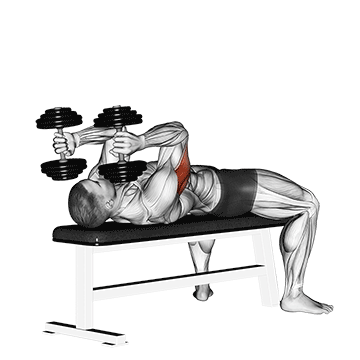
1. Start by selecting a pair of dumbbells of appropriate weight. Remember, it's better to start light and increase weight as you get comfortable with the exercise.
2. Lie down on a flat bench with your feet firmly planted on the ground. Hold the dumbbells in each hand with your palms facing each other.
3. Extend your arms fully above your chest, keeping the dumbbells close together. This is your starting position.
4. Slowly bend your elbows to lower the dumbbells down towards your ears. Keep your upper arms stationary and only move your forearms.
5. Continue lowering the weights until they are about level with your ears. Your elbows should now be at about a 90-degree angle.
6. Pause for a moment at the bottom of the movement, then use your triceps to extend your arms back to the starting position.
7. Repeat this movement for the desired number of repetitions.
Remember to keep your movements slow and controlled, focusing on the contraction of the triceps. Avoid using your shoulders or back to lift the weights, and keep your elbows close to your head throughout the exercise.
dumbbell lying single extension
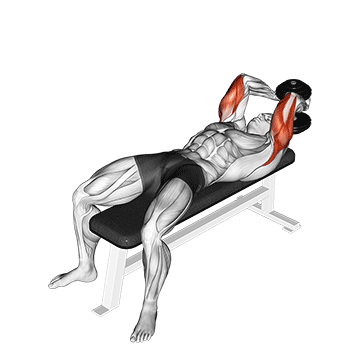
1. Start by selecting a dumbbell of appropriate weight. Remember, it's better to start light and increase weight as you get comfortable with the exercise.
2. Lie down on a flat bench with your feet firmly planted on the ground. Hold the dumbbell in your right hand with your arm fully extended towards the ceiling. Your palm should be facing inwards towards your feet.
3. Slowly bend your elbow, lowering the dumbbell down towards your shoulder. Keep your upper arm stationary and only move your forearm. This is your starting position.
4. Push the dumbbell back up by extending your elbow and flexing your tricep. Ensure your upper arm remains stationary throughout the movement.
5. Pause for a moment at the top of the movement, squeezing your tricep for maximum muscle engagement.
6. Slowly lower the dumbbell back down to the starting position, maintaining control of the weight at all times.
7. Repeat the movement for your desired number of repetitions. Once you've completed a set with your right arm, switch the dumbbell to your left hand and repeat the exercise.
8. Remember to keep your movements slow and controlled, focusing on the muscle contraction and not on the weights you are lifting.
9. Always maintain a neutral spine and avoid straining your neck. If you feel any discomfort or pain, stop the exercise immediately and consult with a fitness professional.
10. This exercise can be performed for 3-4 sets with 10-15 repetitions per set.
dumbbell lying one arm supinated triceps extension
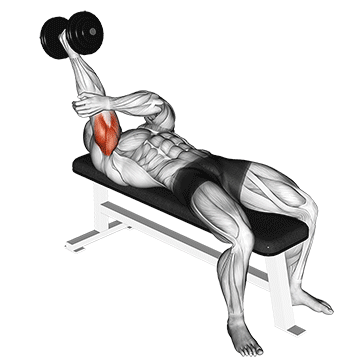
1. Start by selecting a dumbbell of appropriate weight. Remember, it's better to start light and increase weight as you get comfortable with the exercise.
2. Lie flat on your back on a bench or mat, holding the dumbbell in one hand. Your feet should be flat on the floor.
3. Extend the arm holding the dumbbell straight up towards the ceiling, palm facing forward. This is your starting position.
4. Slowly bend your elbow, lowering the dumbbell in an arc towards your shoulder. Keep your upper arm stationary and only move your forearm.
5. Pause for a moment when the dumbbell is close to your shoulder, then push the weight back up to the starting position, fully extending your arm but not locking your elbow.
6. Repeat this movement for your desired number of repetitions.
7. Once you've completed your set, switch the dumbbell to your other hand and repeat the exercise.
8. Remember to keep your movements slow and controlled, focusing on the contraction and extension of the triceps muscle.
9. Always maintain a neutral spine and avoid lifting your back off the bench or mat during the exercise.
10. Breathe in as you lower the dumbbell and breathe out as you extend your arm back to the starting position.
Remember, the key to this exercise is control, not speed. Take your time and focus on the movement of your triceps.
dumbbell lying one arm pronated triceps extension
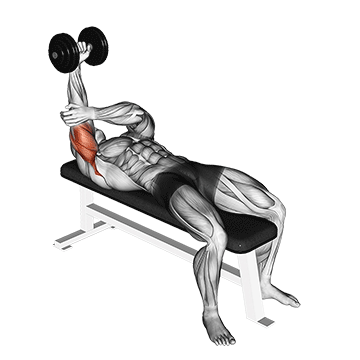
1. Start by selecting a dumbbell of appropriate weight. Remember, it's better to start light and increase weight as you get comfortable with the exercise.
2. Lie down on a flat bench with your feet firmly planted on the ground. Hold the dumbbell in one hand with a pronated grip (palm facing towards your feet).
3. Extend your arm straight up towards the ceiling, keeping your elbow locked. This is your starting position.
4. Slowly lower the dumbbell by bending your elbow, keeping your upper arm stationary. The movement should only occur at the elbow. Lower the dumbbell until it is just above your forehead.
5. Pause for a moment at the bottom of the movement, then push the dumbbell back up to the starting position by extending your elbow. Ensure your upper arm remains stationary throughout the movement.
6. Repeat the exercise for your desired number of repetitions. Once completed, switch to the other arm and perform the same number of repetitions.
7. Remember to keep your movements slow and controlled, focusing on the contraction and extension of the triceps muscle. Avoid using your shoulders or back to lift the weight.
8. Always maintain a neutral spine and avoid arching your back. If you find your back arching, reduce the weight of the dumbbell.
9. Breathe in as you lower the dumbbell and breathe out as you lift it back to the starting position.
10. Repeat this exercise for 2-3 sets of 8-12 repetitions per arm, or as recommended by your fitness professional.
dumbbell lying extension (across face)
1. Start by selecting a dumbbell of appropriate weight. Remember, it's always better to start light and gradually increase the weight as you get comfortable with the exercise.
2. Lie down on a flat bench with your feet firmly planted on the ground. Hold the dumbbell with both hands, using a diamond-shaped grip (thumbs and index fingers touching).
3. Extend your arms fully, holding the dumbbell directly above your chest. This is your starting position.
4. Slowly lower the dumbbell in an arc-like motion towards your forehead. Keep your elbows stationary and close to your head throughout the movement. Only your forearms should move.
5. Continue lowering the dumbbell until it's almost touching your forehead or just above it. Ensure that you maintain control of the dumbbell at all times.
6. Pause for a moment at this position, then push the dumbbell back to the starting position using your triceps.
7. Repeat this movement for your desired number of repetitions.
Remember to keep your movements slow and controlled, focusing on the contraction and extension of the triceps. Avoid using your back or shoulders to lift the weight, and don't let the dumbbell fall towards your face.
dumbbell lying elbow press
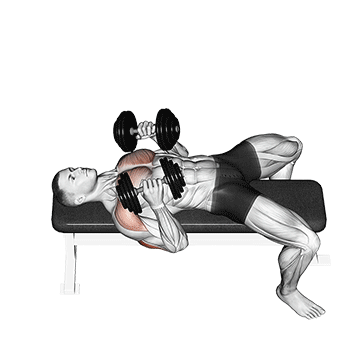
To perform the dumbbell lying elbow press, start by selecting a pair of dumbbells of appropriate weight.
1. Lie down on a flat bench with your feet firmly planted on the ground. Hold a dumbbell in each hand with your palms facing each other.
2. Extend your arms fully above your chest, keeping the dumbbells close together. This is your starting position.
3. Slowly bend your elbows to lower the dumbbells down towards your shoulders. Keep your elbows close to your body and ensure that only your forearms are moving. The dumbbells should be on either side of your head at the lowest point.
4. Pause for a moment at the bottom of the movement, then push the dumbbells back up to the starting position by extending your elbows and contracting your triceps.
5. Repeat this movement for the desired number of repetitions.
Remember to keep your movements slow and controlled, focusing on the muscle contraction and not on the weights you are lifting. Avoid locking your elbows at the top of the movement to maintain tension on the triceps.
dumbbell lying alternate extension
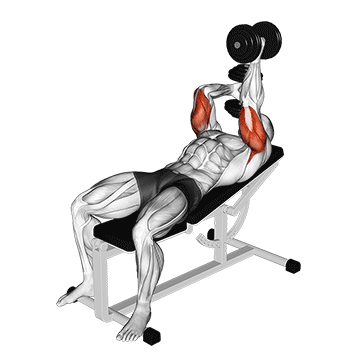
To perform the dumbbell lying alternate extension, follow these steps:
1. Start by lying flat on a bench, holding a dumbbell in each hand. Your feet should be flat on the ground.
2. Extend your arms fully, with the dumbbells directly above your chest. This is your starting position.
3. Slowly lower one dumbbell, bending at the elbow and keeping your upper arm stationary. Continue lowering the dumbbell until it is just beside your head. Your arm should be at about a 90-degree angle.
4. Pause for a moment, then push the dumbbell back up to the starting position, fully extending your arm.
5. Repeat the movement with the other arm. This completes one repetition.
6. Aim for 3 sets of 8-12 repetitions on each arm.
Remember to keep your movements slow and controlled, focusing on the muscle contraction and not on the weights you are lifting. Always keep your back flat on the bench and do not lift your head or shoulders.
dumbbell kickbacks on exercise ball
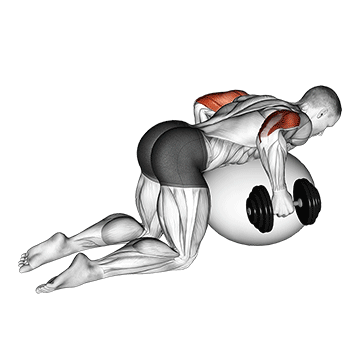
1. Start by selecting a dumbbell of appropriate weight. Remember, it's better to start light and increase weight as you get comfortable with the exercise.
2. Position yourself on the exercise ball by sitting down and then walking your feet forward until only your upper back and shoulders are resting on the ball. Your body should be parallel to the floor.
3. Hold the dumbbell in your right hand with your palm facing in. Keep your elbow close to your body and bent at a 90-degree angle. This is your starting position.
4. Slowly extend your arm backwards until it is fully extended and parallel to the floor. Ensure you keep your elbow stationary and only move your forearm during this movement.
5. Hold this position for a moment, feeling the contraction in your triceps.
6. Slowly lower the dumbbell back to the starting position, maintaining control of the movement.
7. Repeat this movement for your desired number of repetitions.
8. Once you've completed your set, switch the dumbbell to your left hand and repeat the exercise.
9. Remember to keep your core engaged throughout the exercise to maintain balance on the ball and to protect your lower back.
10. For best results, aim for 3 sets of 10-15 repetitions on each arm.
Remember, form is more important than weight. It's better to perform the exercise correctly with a lighter weight than to risk injury with a weight that's too heavy.
dumbbell kickback
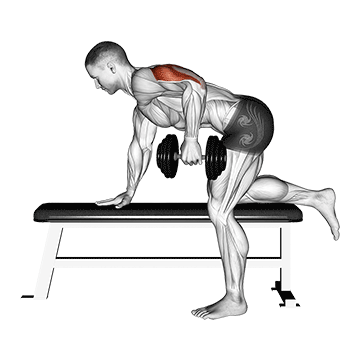
To perform the dumbbell kickback exercise, start by selecting a dumbbell of appropriate weight. Stand up straight with a dumbbell in each hand, arms fully extended, and palms facing your torso. Keep your back straight with a slight bend in the knees and bend forward at the waist. Your torso should be almost parallel to the floor.
Next, keep your upper arms close to your torso and parallel to the floor. The forearms should be pointed towards the floor as you hold the weights. There should be a 90-degree angle formed between your upper arm and forearm. This is your starting position.
Now, while keeping your upper arms stationary, exhale and use your triceps to lift the weights until the arm is fully extended. Focus on moving the forearm.
After a brief pause at the top contraction, inhale and slowly lower the dumbbells back down to the starting position.
Remember to keep your upper arm stationary throughout the exercise. The movement should only happen at the elbow joint. Repeat the exercise for the recommended amount of repetitions.
Ensure to maintain a straight back and keep your head up. The upper arms should remain still throughout the exercise, moving only your forearms.
dumbbell incline two arm extension
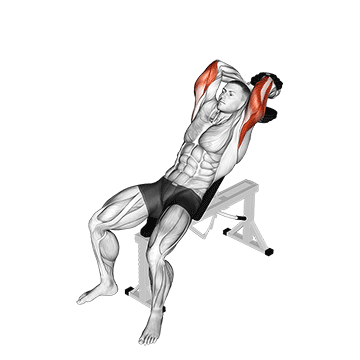
To perform the dumbbell incline two arm extension, start by selecting the appropriate weight of dumbbells. Remember, it's always better to start light and gradually increase the weight as you get comfortable with the exercise.
1. Sit down on an incline bench set at around 45 degrees. Hold a dumbbell in each hand with a neutral grip (palms facing each other), and press them overhead at arm's length. This is your starting position.
2. Slowly lower the dumbbells in a semicircular motion behind your head until your forearms touch your biceps. Keep your upper arms close to your head and elbows at about 90 degrees. The upper arms should remain stationary throughout the exercise, only the forearms should move.
3. Use your triceps to return the dumbbells back to the starting position. Breathe out as you perform this step.
4. Repeat for the recommended amount of repetitions.
Ensure to keep your back flat against the bench throughout the exercise. Avoid using your back or shoulders to lift the weights; your triceps should do all the work. Always perform this exercise in a slow, controlled manner, avoiding any jerky movements.
dumbbell incline triceps extension
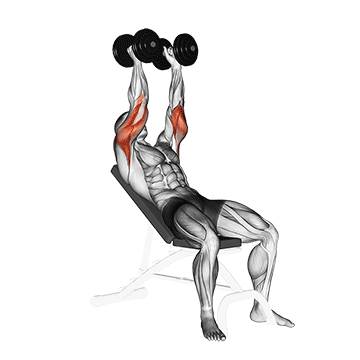
1. Start by selecting a pair of dumbbells of appropriate weight. Remember, it's better to start light and increase weight as you get comfortable with the exercise.
2. Sit down on an incline bench set at a 45-degree angle. Hold a dumbbell in each hand at arm's length above your head, palms facing each other.
3. Slowly bend your elbows to lower the dumbbells behind your head. Keep your upper arms stationary and close to your head at all times. The forearms should do most of the work. Continue to lower the weights until your elbows are at a 90-degree angle.
4. Pause for a moment at the bottom of the movement, then use your triceps to return the dumbbells back to the starting position.
5. Ensure you keep your elbows close together throughout the movement. Avoid using your back or shoulders to lift the weights; your triceps should do all the work.
6. Repeat for the desired number of repetitions.
Remember to maintain good form throughout the exercise, keeping your back flat against the bench and your core engaged. Breathe in as you lower the weights and breathe out as you extend your arms.
dumbbell incline one arm hammer press on exercise ball
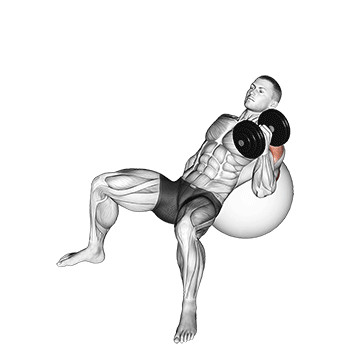
1. Start by selecting a dumbbell of appropriate weight. Remember, it's better to start light and increase weight as you get comfortable with the exercise.
2. Sit on an exercise ball with your feet flat on the floor. Slowly walk your feet forward, allowing the ball to roll up your back until it is supporting your upper back and shoulders. Your knees should be bent at a 90-degree angle.
3. Hold the dumbbell in one hand with a hammer grip, meaning your palm should be facing towards your torso.
4. Extend your arm fully so the dumbbell is directly above your shoulder. This is your starting position.
5. Slowly bend your elbow, lowering the dumbbell towards your shoulder. Keep your elbow close to your body and ensure your other arm is either resting on your hip or holding onto the exercise ball for stability.
6. Once the dumbbell is close to your shoulder, push it back up to the starting position. This is one repetition.
7. Complete your desired number of repetitions on one arm, then switch to the other arm.
8. Remember to keep your core engaged throughout the exercise to maintain balance on the exercise ball.
9. For best results, aim for 3 sets of 8-12 repetitions on each arm.
Remember, the key to this exercise is control. Don't rush through the movements, and always ensure you're using a weight that allows you to complete the exercise with proper form.
dumbbell incline one arm hammer press
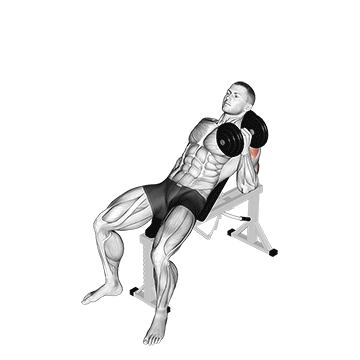
1. Start by selecting a dumbbell of appropriate weight. Remember, it's better to start light and increase weight as you get comfortable with the exercise.
2. Sit down on an incline bench set at about 45 degrees. Hold the dumbbell in one hand, with your palm facing your torso. This is your starting position.
3. Push the dumbbell up until your arm is fully extended, but don't lock your elbow. Keep your other hand on your waist or use it to hold onto the bench for stability.
4. Slowly lower the dumbbell back down to the starting position. Make sure to keep your elbow close to your body throughout the movement to ensure your triceps are doing the work.
5. Repeat the movement for your desired number of repetitions.
6. Once you've completed your set, switch arms and repeat the exercise.
7. For a balanced workout, make sure to perform an equal number of sets and repetitions with each arm.
Remember to keep your movements controlled, focusing on the muscle contraction and not on the weights you are lifting. Always maintain good form and avoid any fast or jerky movements.
dumbbell incline hammer press on exercise ball
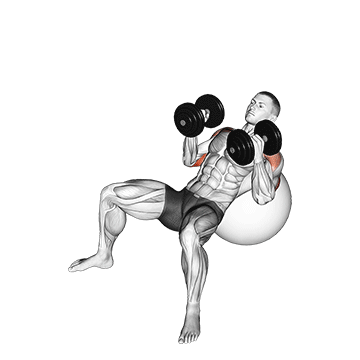
1. Start by selecting a pair of dumbbells of appropriate weight that you can comfortably lift.
2. Position an exercise ball against a wall for stability. Sit on the ball and walk your feet forward, rolling down until your upper back and shoulders are supported by the ball. Your knees should be bent at a 90-degree angle, and your body should form a straight line from your knees to your head.
3. Hold the dumbbells in each hand with your palms facing each other in a hammer grip (thumbs up). This is your starting position.
4. Slowly lower the dumbbells down to the sides of your chest by bending your elbows. Keep your elbows close to your body to engage your triceps.
5. Push the dumbbells back up to the starting position, fully extending your arms but without locking your elbows. Make sure to exhale as you push up.
6. Repeat this movement for your desired number of repetitions.
7. Ensure to keep your hips lifted and your core engaged throughout the exercise to maintain balance on the ball and to protect your lower back.
Remember, the focus of this exercise is on the triceps, so make sure you're feeling the contraction in the back of your arms rather than your chest or shoulders. If you feel strain in your neck or back, reposition yourself on the ball or reduce the weight of the dumbbells.
dumbbell forward lunge triceps extension
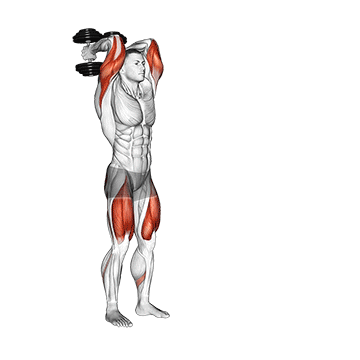
To perform the dumbbell forward lunge triceps extension, follow these steps:
1. Stand upright with your feet hip-width apart. Hold a dumbbell in each hand with your palms facing your body.
2. Step forward with your right foot into a lunge position. Your right knee should be bent at a 90-degree angle and your left knee should be hovering just above the ground.
3. As you step into the lunge, raise the dumbbells above your head, fully extending your arms. Keep your elbows close to your ears and your palms facing each other.
4. Bend your elbows to lower the dumbbells behind your head, keeping your upper arms stationary. This is the triceps extension part of the exercise.
5. Extend your elbows to raise the dumbbells back above your head.
6. Push off your right foot to return to the starting position.
7. Repeat the lunge and triceps extension with your left leg forward.
8. Continue to alternate legs for the desired number of reps.
Remember to keep your back straight and your core engaged throughout the exercise. Also, ensure that your knee does not go past your toes when you lunge forward to avoid injury. The weight of the dumbbells should be challenging but manageable. If you feel any pain, stop the exercise immediately and consult with a fitness professional.
dumbbell decline triceps extension
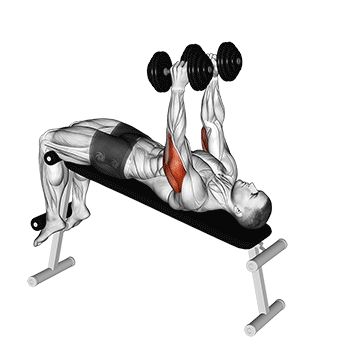
1. Start by selecting a pair of dumbbells of appropriate weight. Remember, it's better to start light and gradually increase the weight as you get comfortable with the exercise.
2. Position yourself on a decline bench, securing your legs at the end of the bench.
3. Hold a dumbbell in each hand and extend your arms fully above your chest, palms facing each other. This is your starting position.
4. Slowly bend your elbows to lower the dumbbells down beside your head. Keep your elbows close to your head and perpendicular to the floor. The dumbbells should be just about level with your ears.
5. Pause for a moment at the bottom of the movement, then use your triceps to extend your arms back to the starting position. Make sure not to use your shoulders or back to lift the weights; your forearms should do all the work.
6. Repeat this movement for the desired number of repetitions.
Remember to keep your movements slow and controlled, focusing on the muscle contraction and not on the weights you are lifting. Always keep your back flat on the bench and avoid any kind of body movement.
dumbbell decline one arm hammer press
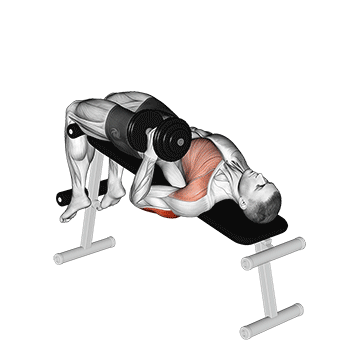
To perform the dumbbell decline one arm hammer press, follow these steps:
1. Start by setting up your decline bench at an angle of about 30 to 45 degrees.
2. Sit on the bench with a dumbbell in one hand. Lay back and bring the dumbbell up to the side of your chest with your palm facing towards your feet. This is your starting position.
3. Press the dumbbell up and away from your chest, extending your arm fully. Ensure your palm remains facing towards your feet throughout the movement.
4. Pause for a moment at the top of the movement, then slowly lower the dumbbell back down to the starting position.
5. Repeat this movement for your desired number of repetitions.
6. Once you've completed your set, switch the dumbbell to your other hand and repeat the exercise.
Remember to keep your movements controlled, focusing on the contraction of your triceps as you press the dumbbell up. Avoid locking your elbow at the top of the movement to maintain tension in your triceps.
dumbbell close-grip press
To perform the dumbbell close-grip press, start by sitting on a flat bench with a dumbbell in each hand. Your feet should be flat on the floor, and your back pressed firmly against the bench for support.
Hold the dumbbells at shoulder width, palms facing each other. This is your starting position.
Exhale and push the dumbbells up with your triceps. Keep your elbows close to your body at all times. Continue the movement until your arms are fully extended above you, but don't lock your elbows.
Pause for a moment at the top, then slowly lower the dumbbells back down to the starting position while inhaling. Ensure you maintain control of the dumbbells at all times; don't let them drop or control the movement.
Repeat this movement for your desired number of repetitions. Remember to keep your movements slow and controlled, focusing on the contraction of the triceps muscles.
Always ensure you're using a weight that's challenging but allows you to maintain proper form throughout the entire set. If you're new to this exercise, start with a lighter weight to get a feel for the movement before gradually increasing the weight.
dumbbell close grip press
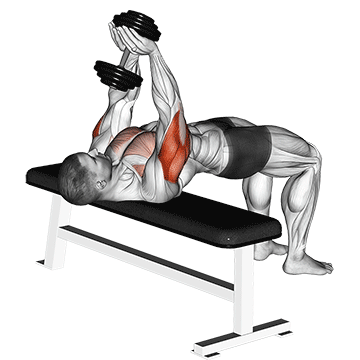
To perform the dumbbell close grip press, follow these steps:
1. Start by sitting on a flat bench with a dumbbell in each hand. Your feet should be flat on the floor.
2. Lie back and raise the dumbbells above your chest, holding them with a neutral grip (palms facing each other). The dumbbells should be touching each other, or as close as possible.
3. Slowly lower the dumbbells towards your chest by bending your elbows. Keep the dumbbells close together throughout the movement. This is your starting position.
4. Push the dumbbells back up to the starting position by extending your arms. Make sure to keep the dumbbells close together as you press them up.
5. Squeeze your triceps at the top of the movement for a second to maximize the contraction.
6. Repeat for the desired number of repetitions.
Remember to keep your movements slow and controlled, and focus on using your triceps to push the weights up. Avoid using your chest or shoulders to push the weights up. The key to this exercise is keeping the dumbbells close together to keep the focus on your triceps.
No tags for this post.
